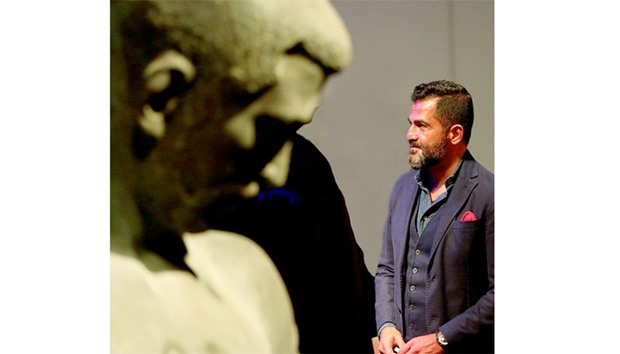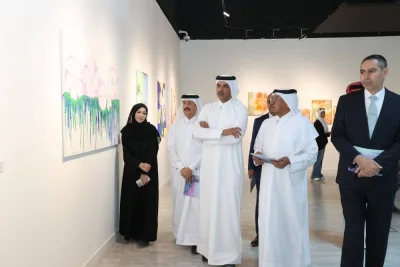Iraq’s Saddam Hussein’s giant statue falls. It is brought down with a rope hanging from his neck. For some it all ends there. For Mahmoud Obaidi and his compatriots, it did not. The rope, still hanging from the former Iraqi strongman’s neck, has death and destruction tied to it and it travels deep into the ensuing chaos.
Seizing each and every moment with its repercussions that are often invisible in the beginning, the Iraqi-Canadian artist Mahmoud Obaidi tells the story of destruction of Iraq after its invasion in 2003. In ‘Fragments,’ he pins the quintessence of turmoil that engulfs his native country.
Obaidi bears witness to the destruction and attempts to recreate all that has been stolen or destroyed as he watches 7000 years of history fall piece by piece.
Through his solo exhibition opened for public at Qatar Museums (QM) Gallery in Katara Cultural Village, the artist traces the fatal tale of destruction through a series of installations, each connected by a rope representing “organised chaos” let loose upon his country.
From the toppled statue of Saddam Hussein to the “new Iraqi family” and a pickup truck carrying remnants of the ancient culture, Obaidi has created an enduring memory of all that has been lost.
Though by attempting to “rebuild the country in a stronger material by casting familiar items with bronze” Obaidi gives hope for a possible future, but he is not too optimistic.
“I don’t think it (war) will end. I am not optimistic about Iraq because they have opened it totally. It is not about ISIS, or this or that, they have destroyed everything. It will take years to recover from it,” Obaidi tells Community in a brief chat at the opening of his exhibition yesterday.
Presented under the leadership of QM Chairperson, HE Sheikha Al Mayassa bint Hamad bin Khalifa al-Thani, the opening of the exhibition was attended by a number of dignitaries and art enthusiasts.
“They have destroyed my country. They have destroyed a civilisation 7,000 years (old) in 13 years. They have not just destroyed it materially; they have destroyed its history (spirit). The destruction has been so well-done in the way that I feel there is a plan behind it. It did not just happen, it was not just a war,” observes Obaidi.
This was an orchestration, he explains, and it has been done in a way that “it will take us another 100 years to get back to what we were before.”
One of the striking pieces in the exhibition called ‘Untitled’ addresses the significance of the fall of the statue of Saddam Hussein in April 2003, which was described as marking the symbolic conclusion of the Battle of Baghdad.
“This moment marked the beginning of a surge in looting and violence that would go on to engulf the city. In this artwork, Obaidi uses the idea of the toppled statue as the starting point for the ‘organised chaos’ that was to follow,” comments Khalid Yousef al-Ibrahim, Chief Strategic Planning Officer at QM.
Another installation called “Ford 71” shows a Ford pickup truck, piled high with relics from the ancient Assyrian, Babylonian and Sumerian cultures.
Obaidi says he gets his inspiration mostly from his surroundings and from what is happening around him but for the past 13 years, it has been Iraq that has inspired his work. “I have my family there. I am next to Iraq. I know what is happening in my country,” says Obaidi.
“They have opened it for everything and everyone. You have militias there, you have no government (rule). There is nothing, it is just an open place,” he observes.
Speaking about his choice of medium for his installations in the exhibition, the artist says he decided to choose this media because it is very close to the war and what has happened. It is rusty.
“I made the jet and the pickup that you see in here. It is not a truck. I made it look like this. The process involves chemicals used on bronze. It was like experimenting with them and changing until I get what I want. It took me a full year working to complete the pieces for this show,” says Obaidi.
The art coming from conflict zones, he says, has not really been able to make the impact on the world outside because the media is stronger than art. The television is stronger. The regular people watch TV, they do not go to the art shows.
“So it is up to the media to cover our shows in the right way to make people understand what is happening,” he suggests. Obaidi says he does not know what kind of an artist he would have been had there been no war.
He was a different kind of artist before the war but it has changed. “It was different. It should have been normal. But now, I don’t know what it would have been like,” he says, adding that he, too, had started like any other artist in his childhood and going on to study art in university.
Maryam Hassan al-Thani, Assistant Curator at QM and the curator of the show, says Obaidi approached her more than six months ago and discussed the idea of this exhibition. What was so amazing about it was that he had seen the QM Katara Gallery and he was certain on what exactly he wanted to create.
“All these works here are specifically made for this exhibition. This entire idea of the show started from the idea of the fall of Baghdad. And the artist tries to create this city back together once it is destroyed,” Maryam tells Community.
A lot of his work tackles the idea of loss and the idea of memory, home and exile, she says. “This exhibition, in particular, was an investigation into what happened. It starts with a large installation of Saddam Hussein’s statue tied to the rope and continued onto this systematic destruction that led to the fall of his home,” says the curator.
One of her favourite pieces is the sculpture titled the “Operation Freedom Iraqi Family.” It is made out of the material from American weapons from Iraq mixed with bronze.
“Statues are usually made to represent high people in the society or for victors or more. So this was made to remember what the bombings have left behind. So you really feel that connection,” says Maryam.
Obaidi, born 1966, is an Iraqi-Canadian contemporary artist. He received a BFA from Baghdad University in 1990, after which he left Iraq to obtain his Masters in Fine Arts at the University of Guelph in Ontario (Canada).
He proceeded with diplomas in media and film in Toronto (Canada) and Los Angeles (US). Obaidi first exhibited in 1989 at Baghdad’s Museum of Modern Art. His work has featured in numerous international group exhibitions and most recently a solo show at the 56th Venice Biennale (2015).

Iraqi-Canadian artist Mahmoud Obaidi


